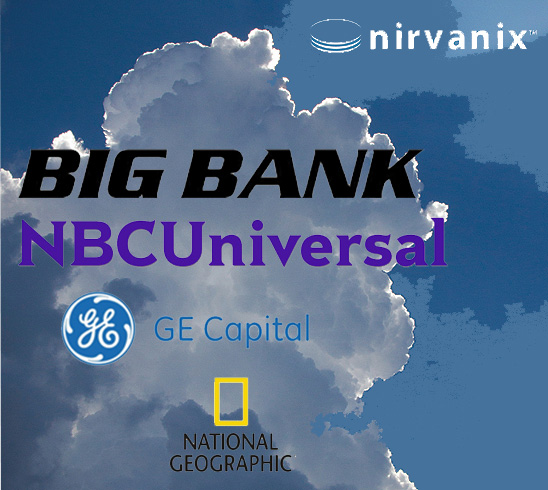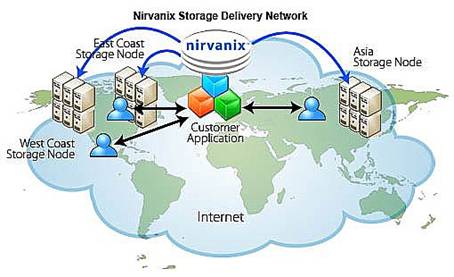IaaS
Nirvanix Brings Petabyte-Scale Data Storage to The Cloud

Large, multinational enterprises are now generating huge amounts of structured and unstructured data as part of their daily business routine. Nirvanix offers secure, flexible cloud storage for public, private and hybrid clouds. We spoke to CEO Scott Genereux about the opportunities and challenges data hosting of such large volumes and where cloud storage is headed.
You can learn more about Nirvanix and cloud storage by visiting their website.
How was Nirvanix founded? What was the inspiration or business need that needed to be addressed?
We aim to service customers with Tier 3 and Tier 4-level storage needs. If you look at some of the other cloud storage providers right now they really lack the DNA for the enterprise space. On the other side of the industry, you have companies like EMC and NetApp. They’re really trying to just sell you a box with software on it.
They do well with enterprise support. They just really refuse to offer usage-based, on-demand pricing. Obviously the big reason they don’t want to do that is for the fear it will collapse their margin structure. So Nirvanix offers high-grade pricing across public, hybrid and private cloud services. We have the enterprise DNA, the enterprise scale IP and we have the enterprise high-tech support structure.
The cool thing about our private cloud environment is that it doesn’t necessarily have to be completely integrated with the customer data center. It’s just dedicated to the customer. It could be part of the customer’s data center. It could be in a secure remote location around the world. It could be anywhere. So we give the customer a lot of flexibility in deciding what they want to do, depending on their business requirement. Then we architect our cloud specifically to what fits their needs. So based on that, it gives the customers a lot of flexibility to be able to do some things that are different. It’s really not related to size or scale. Like I said, we have plenty customers that only use our public storage option. But one thing that’s common with all of it is the flexible usage based, pay-as-you-go type of environment. That’s a huge ROI benefit to customers.
What is your target demographic or the sort of client you’re aiming towards?
We really focus on the Tier 3, Tier 4 space. We enable customers to stop migrating data storage from storage system to storage system. Customers today spend millions of dollars every year on data transfers and migration, because they’re on a three-year cycle.
In this market, there are a lot of customers who need a lot of flexibility when it comes to scale. Obviously the fact is you have shorter time in the market for new products. The interesting thing today is that data is not getting deleted. We really enable companies to adhere to regulatory requirements for secure long-term data retention. Customers need to go and access data complete for potential investigation. More importantly, they also need to be able to monetize some of the data they’re saving. So those are some of the main areas that we’re really focused on.
Nirvanix divides its service into Public, Hybrid and Private Storage plans based on how much data the client wants to retain onsite. Have you seen any trends in terms of what sort of service your clients gravitate towards and has that affected your business strategy at all?
Yeah. That’s a good question. We are the only Cloud provider that does public, private and hybrid. Public, being in one of our locations – we have 11 locations around the world. We are global. That’s one of the things that’s unique about us. As I mentioned, we do allow customers to decide where they’re going to put their data. We guarantee that data won’t leave the country. It’s all built into our architecture.
We have customers, by the way, very large customers that have multiple pedabytes of data in our cloud. So it’s really not always about the size of the customer. It really depends on what the customer wants to do with the data that’s in the cloud. We have a hybrid offering, which you’ve mentioned. The hybrid’s the best of both worlds for the customer’s data environment. It’s still connected to the public cloud, so you’re able to burst data out to anywhere in the world, based on user groups or other offices, different locations and what the purpose is. So the customer gets the best of both worlds.
And for customers who have very large data centers around the world, a private cloud is an option they often select. They really like the usage-based model services model that we offer. We offer a private cloud, which is completely dedicated to that customer’s environment. In every one of those environments, it’s a usage-based type model. And it’s the environment where we run a managed service. We own the underlying architecture of the customer’s environment.

Commentator Tony Asaro has said that Nirvanix has “no viable competitors” in its segment. Do you agree with that? Do you consider other cloud storage services like Amazon S3 and Windows Azure to be your direct competitors?
Yeah. That’s a good question. I get asked this question all the time. There’s no question that Amazon has a service from a business perspective that’s basically a general purpose public cloud service for developers. There are a lot of things that we do around enterprise functionality and IP. I think it’s radically different from Amazon–if you go to their website, they say right on there that it’s a development environment by developers, created by developers, for developers. Right? That’s really what they’re focusing on. So for the enterprise space, we don’t see nearly as much competition from Amazon. Most customers, especially large enterprise customers, don’t feel comfortable giving their business to a cloud provider who won’t even tell them where their data is on the remote network and really won’t guarantee that they’re responsible for their data.
In general, do you think virtualization and software-defined networks will, as a rule, continue to consume more and more of the data storage world at the enterprise level, or is there going to be a saturation point where there will always be a need for the traditional onsite data center?
I mean, it’s like anything, right? I don’t think anything’s going to replace everything. That being said, there are a lot of customers who have their whole environments running in some sort of cloud infrastructure – not only cloud storage, but cloud computing and direct attachment. The customer doesn’t need to own all their assets anymore–from that point of view.
But let’s say if you were a new startup company today–odds are you would not go buy a bunch of hardware with the idea of establishing a full-scale high-level data center. You would use some sort of cloud infrastructure between the types of solutions we have for cloud services for your company. You would likely outsource your storage and compute resources. You might even actually decide that you want to do some sort of hosted software service, depending on which software you needed to build your business. So if you were starting a new company today, there’s no question you would go that direction. You would probably go in that direction pretty aggressively.
But I think for what we do specifically around the secure Tier 3 and 4 space, cloud storage for data is the biggest growth area. When you think about the amount of data that’s been created and will be created over the next two, three, four, five years; 70 to 80 percent of it is this type of data–large unstructured content files that are infrequently accessed. This type of data doesn’t always drive revenue, but you’ve got to keep it. So figuring out where you can put this data–you need it, you need to access it, you need to be able to access it quick and it needs to be available. Cloud storage is a great solution for that. One of the biggest issues is just keep building data center after data center just to warehouse Tier 3-4 data. So do I think that Tier 1 data storage will still be important to the large enterprise customer? Yes. But Tier 3-4 will shift to the cloud.

Where is the cloud storage segment headed in the next five years? What sort of challenges do you foresee Nirvanix and others having to address?
I think the top trends in cloud–one of the big ones we’re starting to see right now–is IT consumers becoming IT providers.
Let’s take the USC Digital Repository for example [a Nirvanix client]. In addition to the fact that they’re using the cloud themselves for internal storage–for backup and archives–they also now are taking their private cloud and they’re selling cloud services out to all their departments. They’re also selling it out to their students. It’s sort of like Cerner healthcare–this two petabyte cloud they have. They use it internally for what they’re doing with medical images, but they’re also going out to all their hospitals and offering storage as a service to all of them. So this idea that we’re starting to see on a big scale is IT consumers are becoming IT providers, and it’s very possible that the HPs and Dells and Hitachis of the world could walk into a hospital and try to sell storage; and what’s happening is they’re going to be competing with people like Cerner, who, today, you may have never heard of for storage. So you’re seeing more and more of that.
I think you’re going to see more and more apps integrated into with cloud backends. The interesting thing about that from an IT perspective is that it’s very possible that some of these companies that would go out and say, “I need storage” would never ever go out and ask the storage vendors for it anymore because the software applications are written to a cloud backend. You see more and application providers go to companies and say, “Hey, you know, we can give you cloud storage through our offering. It’s part of our overall service.” We’re seeing more and more of that.
Another big one is that customers don’t want to be on all sorts of different cloud services. The concept of using different clouds is important, and I think it’s something customers should be looking at. But there’s this corporate-level business need to eliminate the “rogue” cloud users. A lot of them are doing cloud audits. I’ll give you an example: Box.net. They have great service, but it’s very consumer based. A lot of times they’ll say they’ve integrated into 80 percent of enterprises–if I work for GE and I happen to use Box.net, in their mind they’ve “penetrated” GE. The problem we’re running into however, and we’re starting to see it as a result of these cloud audits, is that from an accounting point of view companies are spending a lot of money for these individual accounts that people are expensing. More importantly, the bigger concern than the money, is that we’re running into major security issues with users putting company data into accounts registered in their names. If they get fired or quit, that’s already a huge security risk right there. So I think you’re going to see more and more customers get involved with centralization of cloud usage on their company infrastructure.
If you’re looking for more information on enterprise cloud services our Top 10 Enterprise Cloud Backup software report compiles 10 of the leading cloud backup solutions currently on the market.






